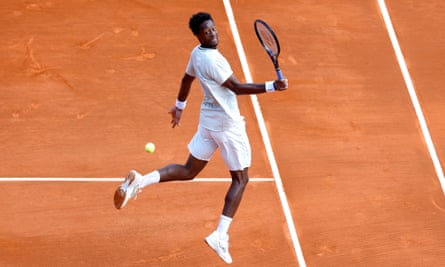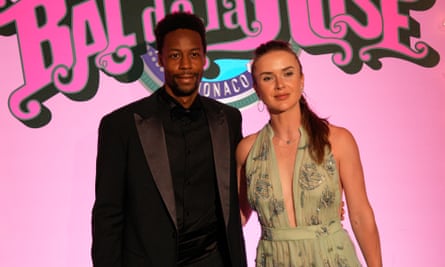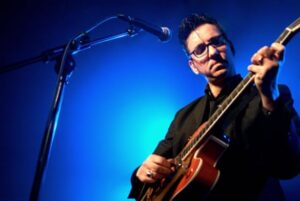At any tournament in almost any part of the world, one of the certainties over the past 20 years is that whenever Gaël Monfils plays, fans are present. Tennis, after all, is entertainment, and there have been few greater entertainers than the 37-year-old. He is one of the purest athletes the sport has seen and displays immense skill, feel and showmanship. At his best, Monfils makes tennis look so easy.
But the Frenchman is adamant that it is not. Especially not in the final years of his career: “[People say] ‘Ah, Monfils is not disciplined’,” he says smiling, from the grounds of the Italian Open on the eve of the tournament. “Guys, don’t think this because I’m enjoying myself on the court. The work I do outside is big.”
Exactly a year ago, Monfils had been at one of the lowest points of his career. For nearly two years, until last summer, he simply could not stay fit. Whenever he did play, it seemed, he would leave the court with a new injury. By last May, Monfils had fallen to No 394 in the rankings. His goal of qualifying for the Paris Olympics in his home city was in tatters.
Those struggles forced Monfils into some serious soul-searching. He had deep conversations with his team, family and his wife – Elina Svitolina – about the future and he constantly credits the Ukrainian former world No 3 for pushing him to continue. As many contemporaries such as Jo-Wilfried Tsonga and Gilles Simon have hung up their rackets, he had questions to answer about his own career mortality.
“Sometimes, I won’t lie, I was doubting a little bit,” he says. “I’m getting a little bit old. I hurt myself. You need to do all this [work]. It’s not easy to come back here. Last year, I was home and trying to call people: ‘Hey, you want to work with me?’ People forget that I still have it and you try to convince the people you still have it. ‘Yeah, but you’re 37 …’”
After working himself into shape in the following months, Monfils’s comeback has been impressive. He is now ranked No 38, the oldest player inside the top 50, and last year he became the fourth-oldest to win an ATP title since 1990. He will easily make the cut for the summer’s Olympic Games.
The immense ability and showmanship exhibited by Monfils has always generated conversation. He has enjoyed an incredible career, reaching a career high of No 6, spending most of his time inside the top 20 and winning 12 titles alongside reaching two grand-slam semi-finals, but he has simultaneously faced ample questions about his work ethic over the years. As he explains the challenge of returning from injury at 37, Monfils delves into the subject unprompted. The perceptions of him being lazy even affected his search for a new coach.

“I’m lucky because some people [believed in me], but some people? Let’s say you don’t really know me, I call you and you’ve heard a lot of stories, you’ve seen my personality on the court. It’s tough [to believe] when I tell you I wake up at seven, I run for two hours, that I can do this work. It’s like this. ‘Yeah, I do it.’
“Some people try to compare my wife and I. My wife looks super-professional in a way and me I don’t look professional in a way. But that’s not really the case because I have my work ethic. I’m working. It’s funny but in the end, it’s not hurting me. The only thing I want is for people to never forget that to succeed or whatever, you don’t have to listen to other people.”
Right alongside questions about his work ethic, Monfils has often been considered an underachiever. For all of his ability, he has struggled to pair his tools with the requisite focus, shot selection and decision-making in the biggest matches of his career. Some believe he has failed to maximise his talent.
“[People] want to maximise potential in everybody,” he says, smiling. “No, it’s not like that. I don’t really care about this because when I was young, the only people – who are now, I hope, super-proud – who believed in me were my parents. When I told them I want to be a tennis player, where I’m from [people responded]: ‘What are you talking about?’ My parents are the ones who are laughing now in a way. [People say]: ‘You could win, you could have this.’ I made my dream. When I was 11 and people asked: ‘What’s your dream?’ I’d say to be in the top 10, being a top professional tennis player. Don’t dream over me. Don’t dream over me or for me.”
As Monfils was dealing with a series of injuries, life began to change. In October 2022, Svitolina gave birth to their first child, Skaï. Monfils had the perfect inspiration for his own return as he watched his wife produce one of the great comebacks of recent years. Just a few months into her return last year, Svitolina reached the quarter-finals of the French Open and the semi-finals of Wimbledon, beating Iga Swiatek, the world No 1, and she simultaneously embraced her position as one of Ukraine’s most prominent international athletes following Russia’s invasion.
after newsletter promotion
“I’m amazed about her,” says Monfils. “She was pregnant, [then] Ukraine [Russia’s invasion] happened. It was a big hit for her. She gave birth and was super-motivated quite early to get back to the top of the game. The work ethic, the discipline that she had, the part that she’s super-involved in Ukraine. She handled the pressure big-time, playing for herself, playing for her country and being a good mum. To be able to have a family, foundation, everything. It’s just like, wow. Behind this girl, there is this strong woman and as I say she’s just amazing.”

Now that both are back in competition and travelling the world but also, along with the rest of their families, looking after their young daughter, life on tour will never be the same. “It’s a constant juggle between tournaments, being at home and as soon as someone loses in the tournament, you have to go back,” says Svitolina, smiling, a few days after Monfils’s first-round loss in Rome.
“We don’t stay there for each other to support, now we have Skaï as a priority. Now Gaël, he lost in the first round so he’s already back home. He spends time with her, he takes care of her. Right now, it’s not the priority that we had before with each other.”
Once the singular priority in Monfils’s life, his tennis is now driven by passion. He says that he continues to play in order to pursue the feeling of contesting the biggest matches on the biggest stages. Alongside the general popularity he has amassed, these latter years of his career have additionally shown his importance as one of the few prominent black players at the top of men’s tennis for so long. Players such as his compatriot Arthur Fils and the American Frances Tiafoe look to him as an older brother figure as well as an inspiration.
The next date on Monfils’s calendar just happens to be the most important of the year: another appearance at the tournament of his life, the French Open, which he describes as his “playground”. At a time when every year could be his last, Monfils will surely take centre stage at Roland Garros as he tries to engineer one more unforgettable run. “I’ve been able to have some crazy emotions, some crazy memories,” he says. “I really hope I have a few more going on and then this chapter will be over.”
Source: theguardian.com


















